In the everevolving world of cryptocurrencies, choosing the right wallet involves multiple factors, and one of the most significant aspects that users consider is transaction fees. This article provides an indepth comparison of the transaction fees associated with imToken and SafePal wallets, helping you make an informed decision about which wallet to use for your crypto transactions.
Transaction fees are the costs that users incur when sending cryptocurrencies from one wallet to another. These fees are usually paid to the network of miners or validators that process and confirm transactions. Understanding how these fees work and what influences their amounts is crucial for any cryptocurrency user.

Transaction fees can significantly affect the net value of your cryptocurrency transactions. Lower fees mean you keep more of your investment. Therefore, examining the fee structures of imToken and SafePal is imperative for users looking to maximize their crypto holdings.
imToken is a popular multichain wallet that supports a range of cryptocurrencies. It is known for its userfriendly interface, robust security features, and support for decentralized applications (dApps). Let's take a closer look at its transaction fees.
If you are sending ETH via imToken, you might see fees ranging between $0.50 to $10 depending on current network conditions. Users can adjust their transaction speed preferences to either expedite the transaction for a higher fee or lower the fee by waiting longer.
SafePal is another crypto wallet that emphasizes security and hardware integration, providing users with a noncustodial experience. It also supports multiple cryptocurrencies and is designed for both novice and experienced users.
When sending BTC from SafePal, users might face a fee of around $1 to $5, depending on the congestion of the Bitcoin network. This consistency can simplify financial planning for regular transactions.
| Feature | imToken | SafePal |
||||
| Fee Type | Variable | Fixed & Lower |
| Customization | Yes (userdefined) | No (set by wallet) |
| Average Range | $0.50 $10 | $1 $5 |
Both wallets offer efficient transaction processing, but imToken's variable fee structure might appeal to those who need flexibility based on immediate requirements, while SafePal's predictability in fees can cater to users looking for stability.
Transaction logic varies considerably between the two platforms. imToken tends to cater more towards active traders who require rapid transactions, while SafePal seems more focused on users who prioritize wallet security and ease of use.
Transaction fees can vary throughout the day. Monitor fee trends and choose to transact during offpeak times.
Example: Use blockchain explorers to gauge network activity and identify the best time to send transactions.
If using imToken, adjust your transaction fees according to your urgency by setting higher fees when speed is essential.
Example: If you notice a spike in network fees, consider slowing down transactions to save costs.
For assets built on Ethereum, exploring Layer 2 solutions like Optimism or Arbitrum might reduce transaction costs.
Example: Transacting on Layer 2 can significantly lower fees while still enjoying the benefits of the Ethereum network.
Minimize the frequency of transactions to avoid incurring multiple fees; consolidate whenever feasible.
Example: Instead of sending small amounts of crypto multiple times, combine them into a single transaction to save on fees.
Familiarize yourself with how blockchain fee markets function, allowing for intelligent decisions during your transaction planning.
Example: Understand how blocks are filled ahead of peak times, ensuring more straightforward and cheaper transaction planning.
A1: For highvolume transactions, imToken offers flexibility with variable fees, which can be advantageous if you can adjust for speed. However, if you're conducting occasional transactions, SafePal’s lower, fixed fee may be appropriate, but always consider current network conditions.
A2: Yes, you can customize transaction fees on imToken. By selecting lower priority settings, you can reduce fees but may face longer transaction times.
A3: While both wallets support numerous cryptocurrencies, imToken is known for its extensive selection, particularly across various blockchains. SafePal also supports diverse options but might have a slightly different focus.
A4: Generally, transaction fees apply to sending cryptocurrencies from one wallet to another, while receiving funds typically does not incur any fees. However, the sender usually pays the fee associated with both wallets.
A5: Transaction fees can be influenced by network congestion and market conditions; however, both imToken and SafePal provide insights into current fee levels, helping users make informed decisions.
A6: To minimize fees, consider transacting during low network activity periods, customizing your transaction speed, and consolidating funds to reduce the number of transactions you initiate.
In summary, understanding the transaction fees associated with imToken and SafePal wallets is essential for effective cryptocurrency management. By tailoring your approach based on your trading habits and preferences, you can ensure that you make the most costeffective decisions, maximizing your crypto investments while minimizing unnecessary costs.